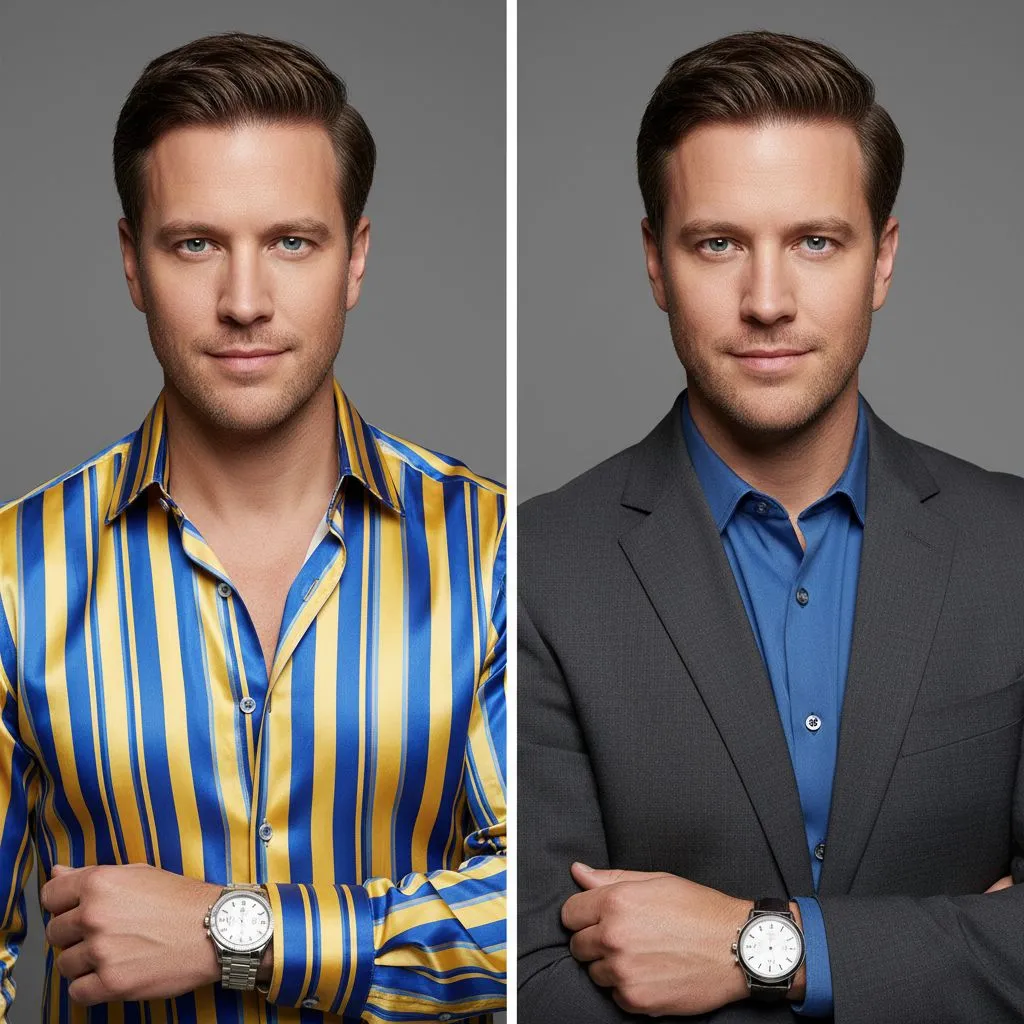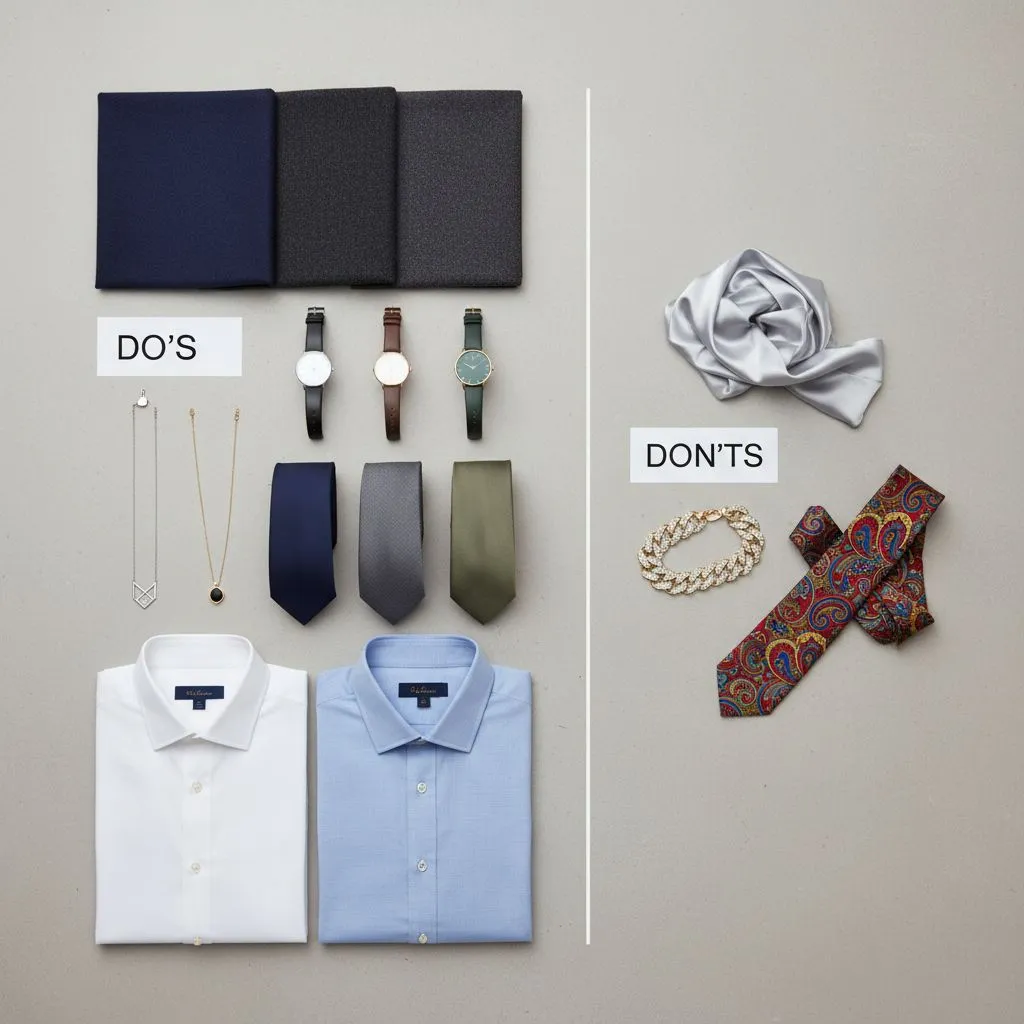What Not to Wear for Headshots: 12 Outfit Mistakes Professionals Still Make
Your headshot is often your first impression—on LinkedIn, your company bio, or a conference page. What you wear matters just as much as lighting and pose. Below are the most common outfit and styling mistakes to avoid, plus what to wear instead for a polished, credible look.
If you’re short on time or wardrobe options, AI-generated portraits can help. With AI Business Headshots, you can upload two selfies, choose your attire, background, and pose, and get professional headshots in seconds—no studio or shopping trip required.
Loading demo video...
See how AI-generated headshots work in seconds
Full transparency: We offer a service that allows you to generate professional, high-quality business headshots with help of AI.
It only takes two input photos and few seconds to generate your very own headshots with our service. We offer lots of configuration options, refunds if you're not happy and you can get started for as little as $5.99.
1) Loud patterns and distracting prints
Busy stripes, houndstooth, and tiny checks can create moiré (a wavy pattern) on camera. Large florals or bold graphics pull attention from your face—the opposite of what you want.
What to wear instead:
- Solid colors or subtle micro-textures (think fine knit or lightly textured weaves)
- If you love patterns, keep them small and low-contrast
2) Bright white or deep black near the face
Pure white can blow out highlights, while true black can swallow detail—especially under studio lighting. Both can make your face look flat or washed out if the exposure compensates incorrectly.
What to wear instead:
- Off-white, cream, soft gray, camel, navy, forest, or burgundy
- Charcoal instead of black; ivory instead of stark white
3) Neon and ultra-saturated colors
Neon shirts or hyper-saturated reds and greens can bounce color onto your skin, making your complexion look unnatural and harder to edit.
What to wear instead:
- Muted, mid-tone colors that complement your undertone (cool: navy, charcoal, jewel tones; warm: olive, camel, teal)
4) Logos, slogans, and brand graphics
Text and logos distract and can date your headshot quickly. They also complicate cropping and editing.
What to wear instead:
- Clean, non-branded pieces that feel timeless and professional
5) Poor fit and wrinkled fabrics
Too-tight shirts pull at buttons; too-loose tops bunch or slump on camera. Wrinkles read as sloppy, and certain fabrics crease as soon as you sit.
What to wear instead:
- Tailored fits that skim the body
- Structured layers like a blazer or cardigan to sharpen your silhouette
- Steam or iron right before the shoot; bring your top on a hanger
6) High-shine fabrics and reflective accessories
Satin blouses, glossy ties, glittery jewelry, and shiny lapels catch light and create hot spots. They can also look dated in corporate contexts.
What to wear instead:
- Matte or lightly textured fabrics
- Simple, non-reflective jewelry and watches
7) Deep plunging necklines or strapless tops
Headshots are often cropped tight. Strapless styles can look “nude” in a tight crop, and deep necklines can feel off-brand for professional settings.
What to wear instead:
- Crew neck, modest V-neck, boat neck, or a collared shirt
- A blazer to frame the face and add structure
8) Sleeveless tops in conservative settings
Sleeveless looks can feel casual or out of place in industries like law or finance.
What to wear instead:
- Cap sleeves or long sleeves
- A jacket to elevate the look without feeling overly formal
9) Overly trendy pieces
What’s fashionable today can look outdated next quarter. Your headshot should last at least 12–24 months.
What to wear instead:
- Classic cuts and simple layers
- Neutral or brand-aligned colors that won’t age quickly
10) Heavy statement jewelry
Large necklaces, oversized earrings, or stacks of bangles draw the eye away from your expression. They also add bulk near the neckline, which competes with your face.
What to wear instead:
- Minimal, delicate jewelry
- One subtle statement piece max (e.g., small hoops or a thin pendant)
11) Glasses gotchas
Transitions lenses, heavy glare, and tinted lenses can hide your eyes—the focal point of a headshot.
What to do instead:
- Choose anti-reflective lenses and clean them before the shoot
- Slightly tilt frames downward or remove lenses temporarily if possible
- Avoid transitions lenses on shoot day
Note: With AI Business Headshots, you can keep your frames and easily minimize glare or color casts in your generated images.
12) Makeup and grooming missteps
New hairstyles or fresh cuts right before a shoot can look too “sharp.” Heavy SPF can cause flashback. Ultra-glossy lips or oily T-zones reflect light.
What to do instead:
- Schedule haircuts 5–7 days prior
- Use a matte or natural-finish base; blot or powder the T-zone
- Keep facial hair neatly trimmed; groom brows
- Choose natural nails; avoid neon or chipped polish
Don’t blend into the background
Your clothing should contrast with the background. A navy suit on a navy backdrop can disappear; a light top on a pale background can wash out.
If you’re unsure, simulate it. With our service, you can preview headshots against white, gray, blurred office, or brand-colored backgrounds and pick the most flattering combo in seconds.

What to Wear Instead: Quick, Reliable Options
Aim for “polished but approachable.” Here’s a fast checklist.
- Solids or subtle textures; mid-tone colors
- A well-fitted blazer or cardigan to structure the shoulders
- Simple necklines: crew, modest V, collared shirt
- Minimal, non-reflective jewelry
- Clean, matte fabrics; avoid sheen
- Light-to-moderate makeup; natural grooming
- Pieces you feel confident in (comfort reads on camera)
Sample outfits by industry
- Corporate or legal: Charcoal or navy blazer, light shirt, simple jewelry, matte tie if applicable.
- Tech or startup: Knit or Oxford shirt, lightweight jacket or cardigan, clean sneakers off-camera are fine.
- Creative or marketing: Add a pop of color or texture (e.g., forest blouse, camel blazer), still minimal patterns.
- Healthcare or education: Friendly neutrals (soft blue, sage, cream) with a clean collar or cardigan.
If you’re doing an in-person shoot
- Bring a lint roller and travel steamer or wrinkle-release spray.
- Pack backups: an alternate top and jacket in different tones.
- Sit-test your outfit to check for pulling or bunching.
- Remove name badges or access cards before shooting.

Short on Time? Let AI Handle the Wardrobe
Getting all these details right can be time-consuming. That’s where AI Business Headshots shines.
- Upload two photos of yourself—no pro camera needed.
- Choose attire, pose, lighting style, and background (corporate gray, modern office, or brand colors).
- Get multiple professional headshots in seconds.
- Generate variations for different platforms or roles.
- Ensure consistency across your team without coordinating outfits or schedules.
This approach eliminates the risk of wardrobe mistakes, avoids scheduling hassles, and gives you polished, on-brand results you can refresh anytime.
Final Takeaway
When it comes to what not to wear for headshots, think “uncomplicated and intentional.” Avoid loud patterns, extreme colors, shiny textures, heavy accessories, and low necklines. Choose solid mid-tones, structured layers, and simple grooming that keeps the focus on your face.
Ready for an effortless upgrade? Try our service to generate studio-quality headshots from two photos in just a few seconds, without worrying about what to wear.
Full transparency: We offer a service that allows you to generate professional, high-quality business headshots with help of AI.
It only takes two input photos and few seconds to generate your very own headshots with our service. We offer lots of configuration options, refunds if you're not happy and you can get started for as little as $5.99.